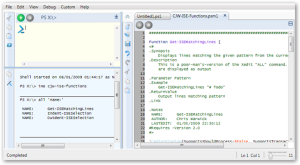The module linked below adds three functions to the ISE editor:
- Indent
- Outdent
- A primitive interpretation of the Xedit “All” macro
To try it out just copy the folder from here: CJW-ISE-Functions.zip and place it under your Modules folder. If you don’t have a Modules folder yet, see This Post on the PowerShell Team Blog, or This Post on Thomas’s Blog.
Here’s a screenshot of the “All” function:
As you’d expect, the Indent and Outdent functions do exactly what they say; default is to in/out-dent by 4 spaces. Indent is mapped to Ctrl-F12 and Outdent to Ctrl-F11.
I’m never quite sure if SkyDrive is going to work, so here’s the CJW-ISE-Functions.psm1 file. This was created with the Module Module!:
Cheers,
Chris
1 ################################################################################ 2 3 Function Get-ISEMatchingLines { 4 <# 5 .Synopsis 6 Displays lines matching the given pattern from the currently active ISE Editor window 7 .Description 8 This is a poor-man's-version of the Xedit "ALL" command. All lines matching the given parameter 9 are displayed as output 10 11 .Parameter Pattern 12 .Example 13 Get-ISEMatchingLines "# Todo" 14 .ReturnValue 15 Output lines matching pattern 16 .Link 17 18 .Notes 19 NAME: Get-ISEMatchingLines 20 AUTHOR: Chris Warwick 21 LASTEDIT: 01/05/2009 22:30:12 22 #Requires -Version 2.0 23 #> 24 25 [CmdletBinding(SupportsShouldProcess=$False, SupportsTransactions=$False, ConfirmImpact='None')] 26 27 Param([Parameter(Position=0, Mandatory=$true, ValueFromPipeline=$true)][String]$Pattern) 28 29 Process{ 30 If ($host.Name -ne 'Windows PowerShell ISE Host'){Throw 'This function only runs in PowerShell ISE'} 31 $psISE.CurrentOpenedFile.Editor.Text -split "`n"|Select-String -pattern $Pattern 32 } 33 } 34 35 ################################################################################ 36 37 Function Indent-ISESelection { 38 <# 39 .Synopsis 40 Indents the current editor selection by the specified number of characters 41 .Description 42 The editor current selection is indented by having a given number of spaces (default=4) 43 inserted before each line in the selection. Note that if the selection does not start 44 on a line-break boundary this cannot be detected and indenting will occur from the start 45 of the selection irrespective of its actual place in the line. 46 47 .Parameter Spaces 48 .Example 49 Indent-ISESelection 8 50 .ReturnValue 51 Selected lines indented 52 .Link 53 54 .Notes 55 NAME: Indent-ISESelection 56 AUTHOR: Chris Warwick 57 LASTEDIT: 01/05/2009 22:30:12 58 #Requires -Version 2.0 59 #> 60 61 [CmdletBinding(SupportsShouldProcess=$False, SupportsTransactions=$False, ConfirmImpact='None')] 62 63 Param([Parameter(Position=0, Mandatory=$false, ValueFromPipeline=$false)][Int]$indent=4) 64 65 Process{ 66 If ($host.Name -ne 'Windows PowerShell ISE Host'){Throw 'This function only runs in PowerShell ISE'} 67 $psISE.CurrentOpenedFile.Editor.InsertText( 68 ($psISE.CurrentOpenedFile.Editor.SelectedText -split "`n"|%{$_ -Replace '^', (' '*$Indent)}) -join "`n" 69 ) 70 } 71 } 72 73 ################################################################################ 74 75 Function Outdent-ISESelection { 76 <# 77 .Synopsis 78 Outdents the current editor selection by the specified number of characters 79 .Description 80 The editor current selection is outdented by having a given number of spaces (default=4) 81 removed before each line in the selection. Note that if the selection does not start 82 on a line-break boundary this cannot be detected and outdenting will occur from the start 83 of the selection irrespective of its actual place in the line. 84 85 The outdenting process will only remove whitespace characters from the start of each line. 86 If whitespace characters run out then no shifting will occur 87 88 .Parameter Spaces 89 .Example 90 Outdent-ISESelection 8 91 .ReturnValue 92 Selected lines outdented 93 .Link 94 95 .Notes 96 NAME: Outdent-ISESelection 97 AUTHOR: Chris Warwick 98 LASTEDIT: 01/05/2009 22:30:12 99 #Requires -Version 2.0 100 #> 101 102 [CmdletBinding(SupportsShouldProcess=$False, SupportsTransactions=$False, ConfirmImpact='None')] 103 104 Param([Parameter(Position=0, Mandatory=$false, ValueFromPipeline=$false)][Int]$Outdent=4) 105 106 Process{ 107 If ($host.Name -ne 'Windows PowerShell ISE Host'){Throw 'This function only runs in PowerShell ISE'} 108 $psISE.CurrentOpenedFile.Editor.InsertText( 109 ($psISE.CurrentOpenedFile.Editor.SelectedText -split "`n"|%{$_ -Replace "^\s{0,$Outdent}"}) -join "`n" 110 ) 111 } 112 } 113 114 ################################################################################ 115 116 $Null=$psISE.CustomMenu.Submenus.Add('Indent', {Indent-ISESelection}, 'Ctrl+F12') 117 $Null=$psISE.CustomMenu.Submenus.Add('Outdent', {Outdent-ISESelection}, 'Ctrl+F11') 118 119 Export-ModuleMember Get-ISEMatchingLines, Indent-ISESelection, Outdent-ISESelection 120 121 Set-Alias All Get-ISEMatchingLines -Scope Global 122 Set-Alias Indent Indent-ISESelection -Scope Global 123 Set-Alias Outdent Outdent-ISESelection -Scope Global 124 125 ################################################################################
